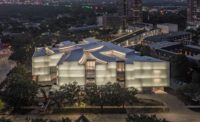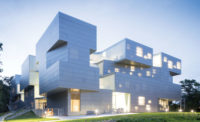Houston's Museum of Fine Arts Unveils Campus Expansion Projects by Steven Holl and Lake|Flato




























Architects & Firms
Steven Holl Architects (which beat out Snøhetta and Morphosis, the two other firms shortlisted in 2011) will design the master plan for the Fayez S. Sarofim Campus, along with two of the buildings for the expansion: the 164,000-square-foot Nancy and Rich Kinder Building to house the museum’s collection of 20th- and 21st-century art, and a new facility for the Glassell School of Art. The project, which is due to start construction later this year and slated for completion in 2019, will also include the Sarah Campbell Blaffer Foundation Center for Conservation, a series of light-filled sheds perched atop the museum’s existing parking garage, designed by San Antonio firm Lake/Flato. To date, $330 million of the $450 million capital and endowment goal has been raised in the Houston Museum District.
The project’s centerpiece, the Kinder building, will hold 25 galleries—all of them day lit, say Holl and his partner Chris McVoy. A truncated triangle in plan, the building will be interspersed by seven inset gardens with reflecting pools along its perimeter. It will wear a “cool jacket”—said Holl at the January 15 presentation in New York City: a facade of glass tubes open at the top and bottom, intended to admit generous daylight while greatly reducing solar heat gain. The roof, which Holl describes as a “luminous canopy,” is a series of warped plates that shift up and out in different directions, much like flakes of dry mud on a desert floor. “Where the roof cracks, light will sneak in,” said Holl.
The expansion will build on the rich architectural tradition of a campus that includes the original William Ward Watkin Greek Neoclassical building from 1924; Mies van der Rohe’s curved glass-and-steel Cullinan Hall (1958, 1974); a cloistered sculpture garden designed by Isamu Noguchi (1986); and an Indiana-limestone-clad building by Rafael Moneo (2000). “Art museums today are the most important buildings,” said Holl, talking about commission. “They are social condensers. This will probably be the most important project I’ll ever do.”

















